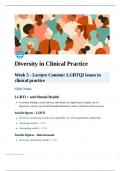🌐
Diversity in Clinical Practice
Week 5 - Lecture Content: LGBTQI issues in
clinical practice
Slide Notes
LGBTI + and Mental Health
Consistent findings: sexual minority individuals are significantly at higher risk for
depression, anxiety, and suicidal thoughts/behaviours when compared to heterosexuals.
Suicide figures - LGBTI
Seriously considering suicide was reported by 40% of sexual minority adolescents
Planning Suicide - 34.9%
Attempting suicide - 24.9%
Suicide Figures - Heterosexuals
Seriously considering suicide - 14.8%
Diversity in Clinical Practice 1
, Planning suicide - 11.9%
Attempting suicide - 6.3%
Sexual minorities experience distinct, chronic stressors relate to their stigmatised identities,
including victimisation, prejudice, concealment of one’s sexual orientation or gender
identity and discrimination.
LGBTI + and Mental Health cont.
minority stress theory (Meyer 1995, 2003) provides a foundational framework for
understanding sexual minority mental health disparities.
Three stress processes from distal to proximal:
1. Objective or external stressors, which include structural or institutionalised discrimination
and direct interactions of victimization or prejudice.
2. One’s expectation that victimization or rejection will occur and the vigilance related to
these expectations
3. The internalization of negative social attitudes - often referred to as internalised
homophobia.
Intra-minority Stress
Pachankis (2019): gay men frequently cite their interactions with other gay men and with the
larger gay community as a source of stress.
→Gay community experienced as being overly focused on:
sex
status
competition
not very welcoming of diversity in terms of race/ethnicity
(older) age
HIV status
LGBTI + MH in context of Ethnic, Cultural, and Religious Factors
Migrants and refugees with a LGBTI background
Diversity in Clinical Practice 2
, are more likely to face negative reactions from their family or (religious and cultural)
community (SCP, 2014).
LGBTI refugees have often endured multiple traumatic experiences, being targeted for their
sexual orientation or gender identity.
Intercultural Psychodynamic LGBTI+ Group Therapy
Double minority patients with recurring anxiety and depression symptoms
Maladaptive patterns of excessive avoidance, compulsivity/overachievement, excessive
dependence/subjugation (controlling), antagonism, impulsive self-harming behaviours.
Dominant themes: fitting within cultural peer group, fitting in within LBGTI + community,
disillusionment* with ‘gay capital of europe’, jealousy towards cisgender/heterosexual
peers, guilt/shame toward family, aftermath of persecution and imprisonment, integrating
sexual/gender identity within broader identity, realistic self-appraisal formulating own
desires and life goals.
*a feeling of disappointment resulting from the discovery that something is not as good as one
believed it to be
Covert and Overt Bias/Discrimination /Homophobia/Transphobia in
Clinical Practice
“it’s a phase, a lifestyle, a choice”
“it's a degenerate western phenomenon”
“A gay man just not met the right woman yet, and a lesbian woman not the right man”
“You become gay, lesbian, transgender because of trauma or abuse”
“All gay men are feminine”
“I would have never suspected you to be gay”
Triangle of Conflict
Diversity in Clinical Practice 3
, Defense: Splitting, Projection, Denial, Denial by fantasy, Projective Identification
Anxiety: Discharged in striated muscles (sighing and muscle tension)
Discharged in smooth muscles (nausea)
Hidden feelings/Impulse: Homosexual desires/impulses.
→Can be applied to case study of Syrian man:
30-year old Syrian male presents with depression symptoms, chronic loneliness, ‘porn’
addiction
identifies as homosexual and cisgender
‘disillusioned’ with gay scene, doesn’t believe 2 men can build a lasting relationship
acknowledges but minimizes influence of religion, cultural factors, family pressure
wants help in dating women and starting a family
explicitly asks to ignore his homosexual orientation
Take Home Message
Contextualise LGBT+ themes in the triangle of sexology, (sub) cultural factors, queer theory
and possible psychopathology.
be mindful of both under and over diagnosing, premature normalizing VS premature
pathologizing
Diversity in Clinical Practice 4




